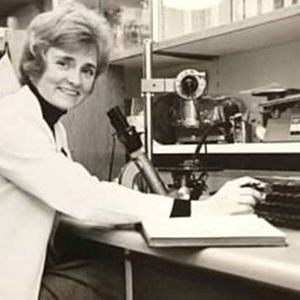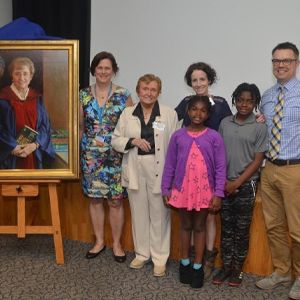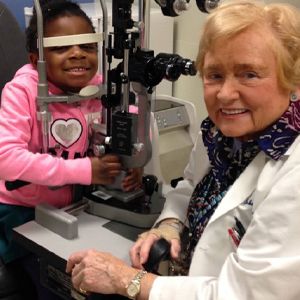I have had the pleasure of knowing Dr. Deborah Pavan-Langston, since 1986, when I joined Massachusetts Eye and Ear as an ophthalmology resident.
At the time, Dr. Pavan-Langston was an associate professor of ophthalmology at Harvard Medical School and director of the cornea service at Brigham and Women’s Hospital. Dr. Pavan-Langston supervised me as a second-year resident, and frankly, I was a bit intimidated by her accomplishments and expertise, even though she was extremely down-to-earth. Dr. Pavan-Langston was clearly an efficient and knowledgeable clinician who taught in a no-nonsense manner and was also a very generous teacher and mentor.
Over the years, I came to admire her brilliance, tenacious spirit and — most of all — humility. Dr. Pavan-Langston has made a profound impact as a clinician, researcher, and mentor over the last three decades and has served as an inspiration to women ophthalmologists as a true pathfinder.
Dr. Pavan-Langston ’s mother, Elmyra Reed Pavan, a lawyer, played a major role in her educational and professional trajectory towards medicine. In Dr. Pavan-Langston’s senior year of high school, her mother “gently informed” her that she would be applying to Radcliffe and Massachusetts Institute of Technology (MIT). It was helpful, as Dr. Pavan-Langston has admitted to being rather “clueless” about college. To that end, Dr. Pavan-Langston recalls being “pretty sure” that her mother filled out the required college applications, as she remembers nothing about the grueling application process. Dr. Pavan-Langston was accepted to both schools and remembers her mother ultimately choosing Radcliffe for her after “much anguish.”
As graduation from Radcliffe approached, Dr. Pavan-Langston’s mother encouraged her to apply to medical school, which was not a popular path for women in those days. Against the advice of her academic Dean — who thought nursing was a more suitable career for a young woman — Dr. Pavan-Langston applied to four medical schools and was accepted by all. After earning her undergraduate degree from Radcliffe in 1961, Dr. Pavan-Langston entered Cornell University Medical College in New York City as one of only five women in her 105-member medical school class. In 1965, Dr. Pavan-Langston earned her MD degree, graduating Alpha Omega Alpha at the top of her class.
With aspirations to be a surgeon, Dr. Pavan-Langston applied to eight surgical residency programs and was turned down by all. Once again, Dr. Pavan-Langston’s mother stepped in and suggested she try ophthalmology — which combines surgery and medicine — a suggestion that benefited us all!

Dr. Pavan-Langston in her laboratory at Mass Eye and Ear.
Dr. Pavan-Langston wrote to Massachusetts Eye and Ear Infirmary and was surprised when she received a letter back from Dr. David G. Cogan, chief of ophthalmology at Mass Eye and Ear and chairman of the department of ophthalmology at Harvard Medical School, saying “We have never taken a woman.” Absent a flat-out rejection, Dr. Pavan-Langston saw an opening in the response from Dr. Cogan and seized the opportunity to request an application.
To her amazement, she received an invitation to join the other applicants on residency interview day. Dr. Pavan-Langston postulates that Dr. Cogan might have been swayed by his mother’s experience. Dr. Edith Ives Cogan trained in ophthalmology at Women’s Medical College of Pennsylvania and was one of the first three women ophthalmologists to practice at Mass Eye and Ear (Before Dr. Pavan-Langston).
In 1966, after an exhausting day of multiple interviews, giving a one-hour seminar to the Howe Laboratory staff on viral disease and flying up and back from New York City, Dr. Pavan-Langston became the first woman accepted into the 130-plus year-old ophthalmology residency training program at Mass Eye and Ear/Harvard Medical School. Of note, all male residency applicants had only two interviews and gave no lectures.
Before Dr. Pavan-Langston could begin her clinical residency, she was required to complete a two-year National Institutes of Health research fellowship in ophthalmology — something that was not expected of her male resident colleagues. Dr. Pavan-Langston worked with Nobel Laureate, Dr. John F. Enders, conducting research in tissue culture (for which he was awarded the Nobel Prize) and virology before beginning her ophthalmology residency in 1968.
Toward the end of her residency training, Dr. Pavan-Langston gave a talk on Herpes Simplex of the eye, catching the attention of Dr. Claes Dohlman, founding director of the cornea service at Mass Eye and Ear. In 1969, Dr. Pavan-Langston achieved yet another first when she became the first woman cornea fellow at Mass Eye and Ear as one of Dr. Dohlman’s fellows.
Dr. Pavan-Langston’s early career trajectory was a sign of great things to come. She joined the cornea service at Mass Eye and Ear and Harvard Medical School in 1971, also serving as the director of the virology-uveitis laboratory, first at Mass Eye and Ear and then at Schepens Eye Research Institute from 1968 to 2012.
A highly sought-after surgeon and expert in corneal disease, Dr. Pavan-Langston became the first woman director of the Mass Eye and Ear cornea service, a role in which she served until 1977. From here, her career flourished, and Dr. Pavan-Langston moved quickly up the ranks as a clinician-scientist, teacher, and leader.
At the height of her clinical career, Dr. Pavan-Langston saw an average of 1,500 patients in the Mass Eye and Ear cornea service each year, all while managing multiple leadership and advisory roles, at regional and national levels. She chaired the Federal Drug Administration (FDA) Ophthalmic Drug Advisory Committee and also served on the President’s Commission on Bioterrorism Preparedness and Response Committee at the Centers for Disease Control and Prevention (CDC).

Dr. Miller (left) stands with Dr. Pavan-Langston and members of her family at her portrait unveiling ceremony at Mass Eye and Ear.
When I became chair of Harvard Ophthalmology in 2003, I investigated why Dr. Pavan-Langston had not yet been promoted to professor, given her numerous accomplishments and profound contributions to ophthalmology and across the tripartite academic mission at Harvard Medical School. Thankfully, I was able to successfully shepherd her promotion, as Dr. Pavan-Langston achieved the rank of professor of ophthalmology at Harvard Medical School in 2009, a proper reflection of her extraordinary and accomplished career.
In addition to her impressive administrative resume, Dr. Pavan-Langston’s pioneering work in ocular virology made her an internationally recognized authority on ocular herpetic diseases — the most common cause of corneal blindness in the developed world. Dr. Pavan-Langston’s research in ocular virology has resulted in innovations that have greatly improved patient care and public health for Herpes Simplex and Herpes Zoster diseases.
Always a trailblazer, Dr. Pavan-Langston was among the first in her field to study the efficacy and toxicity profiles of antivirals in animal models and patients, as well as the first to report on treatment outcomes and diagnostic tests in patients with eye disease. She was also among the first to publish formal diagnostic categories for ocular Herpes Simplex samples based on specific etiology. The publication of these diagnostic categories aided in better treatment for this disease, and this system is still used internationally and continually refined by clinicians. She was also the first to introduce the significance of pain in Herpes Zoster ophthalmicus.
Dr. Pavan-Langston’s landmark work helped pave the way for FDA-approval of three ocular antivirals — trifluridine, acyclovir, and vidarabine — all of which are used to treat patients with corneal herpetic disease. Her extensive published works, which include over 250 original research articles, chapters, and reports, have guided three generations of cornea specialists, and influenced countless other students, ophthalmologists, and researchers around the world.
Her single-authored textbook, “The Manual of Ocular Diagnosis and Therapy,” is one of the most widely read ophthalmology texts in the world. Originally published in 1980, this text is now in its sixth edition and is published in seven languages. As a testament to this, Dr. Gena Heidary, once commented that Dr. Pavan-Langston’s “commitment to clinical excellence is inspirational. I still carry her sheet outlining the management of patients with herpetic eye disease with me every day in my work bag…a reminder of her teaching and influence upon us all.” Dr. Pavan-Langston’s educational efforts are lasting and far-reaching, as Dr. Dasa Gangadhar, shared that “her fingerprint is on every herpetic patient to whom I render care.”
A beloved teacher and generous mentor, Dr. Pavan-Langston not only made a tremendous impact on my career as a colleague and trusted friend, but she influenced generations of ophthalmologists and vision researchers, and was instrumental in training all of the fellows, residents, and medical students who came through the cornea service at Mass Eye and Ear. In fact, many of Dr. Pavan-Langston’s former trainees credit her as the reason they chose their specialty!
Of the more than 50 trainees she directly mentored in her laboratory and clinics, more than half have pursued careers in academic medicine, with seven former trainees currently serving as department chairpersons for their academic institutions. When reflecting on their time under Dr. Pavan-Langston’s tutelage, her former students fondly described Dr. Pavan-Langston as, “generous with her time,” “enthusiastic about her work,” “an inspirational force,” and “a very positive person no matter the circumstance.” Her teaching has been called a “lesson in humanism,” and “one of the greatest gifts of my career.” But, perhaps Dr. Andrea Cruzat, said it best when she described Dr. Pavan-Langston as “a living legend and leader to learn from for all the women in this world.”

Dr. Pavan-Langston with her granddaughter Seneca.
Throughout her career, Dr. Pavan-Langston’s contributions have been recognized with many significant honors and some of the highest awards given for her field and specialty. In particular, she is only one of two people, and the first woman, to receive three of the highest international cornea awards: the Castroviejo Medal for outstanding contributions to the field of corneal and anterior segment disease (1996), the Phillips Thygeson Plaque for outstanding research in corneal disease (2005); and the Claes Dohlman Society Award (2016).
In 2011, Dr. Pavan-Langston was honored at the 385th Harvard graduation and the 50th reunion of her Harvard class of 1961, when she was one of only three members to be inducted into Alpha Iota of Massachusetts, the Harvard College chapter of Phi Beta Kappa. This honor is one of Harvard’s most prestigious and a very fitting testimony to Dr. Pavan-Langston’s pioneering work as a clinician-scientist and educator.
Dr. Pavan-Langston (sort of) retired in 2015 at the pinnacle of her profession, 50 years after entering the field, but has continued to publish results of long-term, ongoing studies with her former fellows. In that same year, Dr. Pavan-Langston joined the Board of Trustees at Mass Eye and Ear, where she continues to contribute her passion and expertise to our mission. We were thrilled to unveil a portrait of Dr. Pavan-Langston outside Meltzer Auditorium at Mass Eye and Ear in the hall of “greats.” Not only an accomplished surgeon, scientist, and teacher, Dr. Pavan-Langston is also devoted to her family — in particular, her daughter Wyndam Ayares, EdD, son-in-law Joshua Ayares, DArch, and granddaughters Nyah and Seneca.
The babysitting hours Dr. Pavan-Langston puts in with Nyah and Seneca is something she clearly relishes in her “retirement!” Her son Talcott is a Wall Street computer scientist in New York City, and her brother Dr. Peter Reed Pavan, (Retina) is another illustrious graduate of the ophthalmology residency training program at Mass Eye and Ear/Harvard Medical School, and chair Emeritus of Ophthalmology at the University of South Florida.
Throughout her storied career and life, Dr. Pavan-Langston has influenced and inspired three generations of women to pursue their passions and goals in academic medicine and private practice. She has shown by example what it means to strive for excellence in one’s life, and the value of perseverance, no matter how challenging the task.
Ever humble, Dr. Pavan-Langston would be the first to downplay her role as a pioneering woman surgeon, but those of us who have followed her know that our success is possible because of her courage and persistence and others like her. She has been profoundly inspirational to me, and to everyone around her — women and men! As a woman, clinician-scientist and trailblazing pathfinder, her contributions will continue to resonate for generations to come.